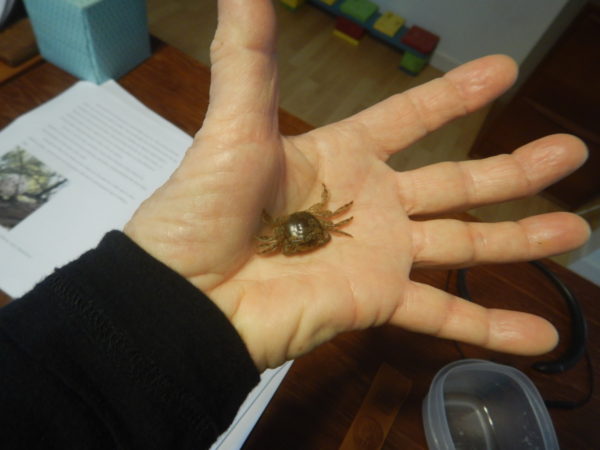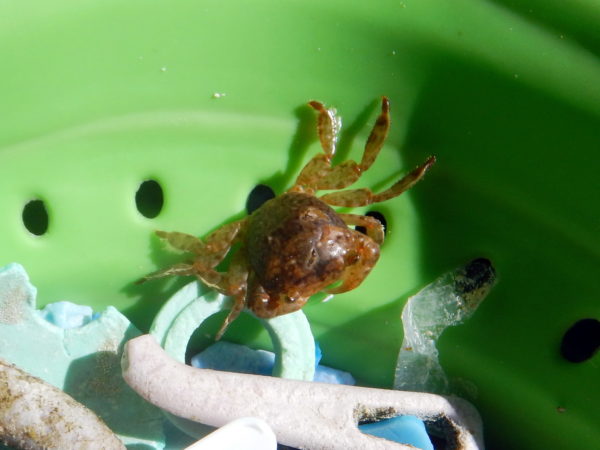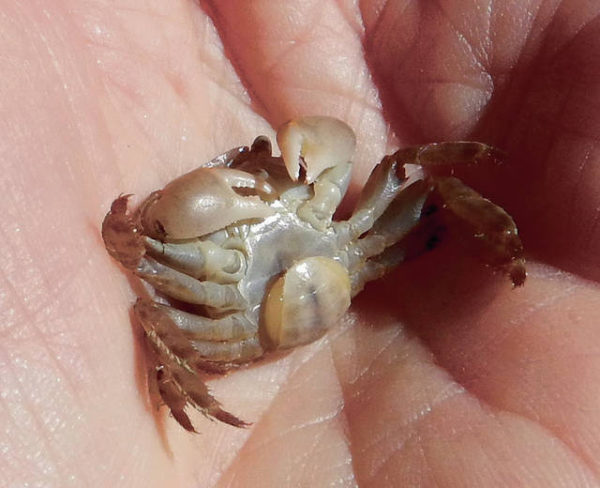Published in the Ocean Watch column, Honolulu Star-Advertiser © Susan Scott
February 3, 2018
When the wind is howling and the surf is busy salting everything in my house, I hit the beach. Those aren’t the best conditions for soaking up sun or playing in the water, but for us avid walkers it’s prime time for finding marine treasures.
Because I make mosaics from litter I find in albatross nests at Midway and on beaches in the Pacific, my gems are usually bits and pieces of colored plastic. Last week, though, my prize was alive. When I got home and dumped my junk in a colander for rinsing, there on a barnacle- and algae-encrusted toy truck clung an offshore crab.
 A pregnant clinger crab fits in the palm of a hand.
A pregnant clinger crab fits in the palm of a hand.
©2018 Susan Scott
This species of crab is a member of the wind drift community, a diverse bunch of animals that float on the surface eating anything they run into, including each other. They’re called wind drifters because they are indeed adrift, their direction and speed controlled entirely by current, wind and waves.

Common jelly-type critters floating offshore are Portuguese men-of-war (Physalia), by-the-wind sailors (Velella) and blue buttons (Porpita).
You might not expect snails to be members of this community, but two species are common: violet snails (Janthina) and snails-without-shells called nudibranchs (Glaucus).
Another unlikely offshore mariner is a little crab I call the clinger crab because it doesn’t have its own float system, as the others do, nor does it swim. Rather, the clinger crab spends its life hanging onto a piece of wood or debris. (I can’t find a common or scientific name for this little crab. If you have one, please write.)
Clinger crabs are about the size of a quarter and come in shades of blue or brown, depending on which object they’ve chosen to call home. This clinger was brown, a perfect match to the brown seaweed that grew on its floating toy.
You can tell a male crab from a female by the flap on the center of its underside. Narrow is male; females have wide flaps that hold their eggs.
When I examined my crab’s belly, I discovered, with some excitement, that I had a female with eggs. Hoping to raise some baby clingers, I rushed back to the ocean for a bucket of water, half filled my rescue tank and gave my pregnant crab her tiny truck, a pile of rocks to reach it and some frozen brine shrimp for energy.
 A pregnant clinger crab fits in the palm of a hand.
A pregnant clinger crab fits in the palm of a hand.
The eggs are the yellow mass under the flap.
©2018 Susan Scott
Alas, a tank being the utter opposite of her natural habitat, she did not survive. Even so, I was happy to have had a wind drift pet, even if just for a day.
During my beach walks I sometimes forget to bring a bag, and have to go trash-can diving for containers. Failing at both those things last week, I called Craig to come get me in the car, because I couldn’t walk home. After stuffing my pockets full of flotsam, I then filled my Crocs.
I have lived in Hawaii long enough that I sometimes think it’s too cold to go snorkeling. Never, ever, though, is it too cold for beachcombing.